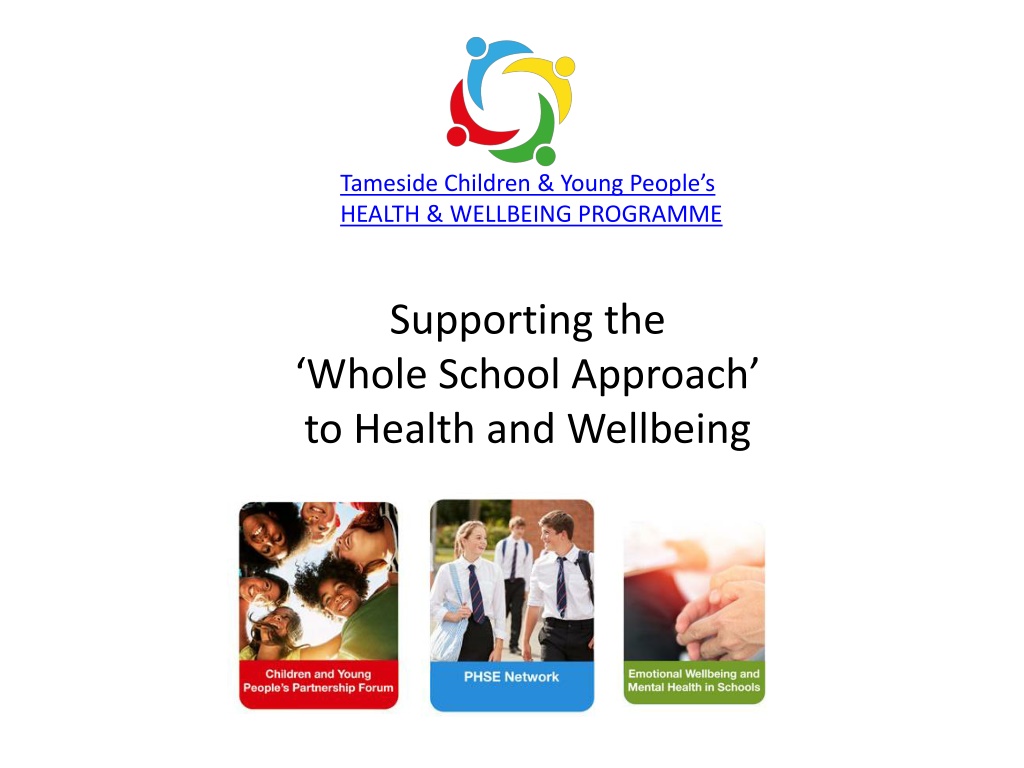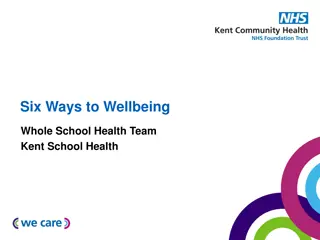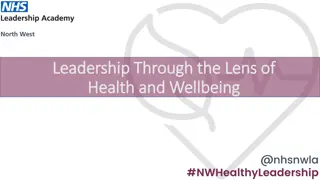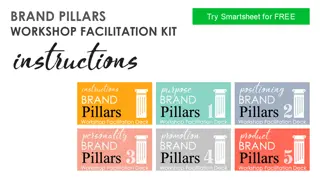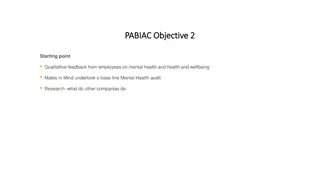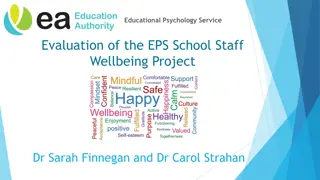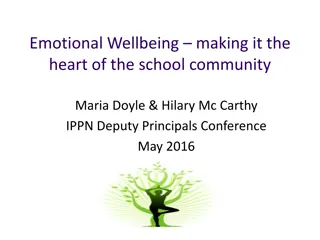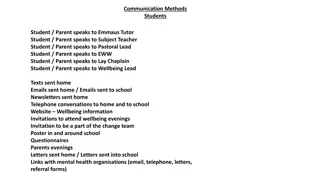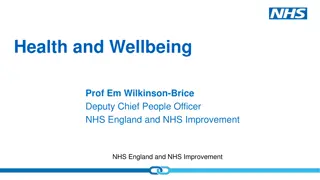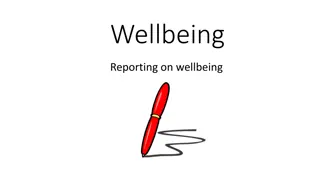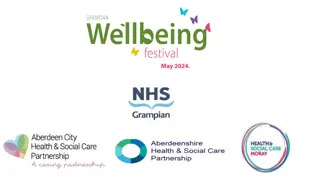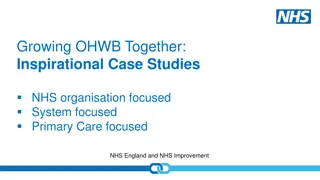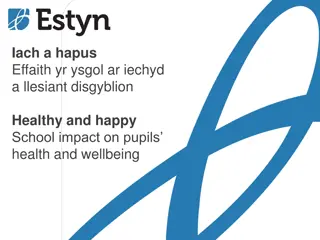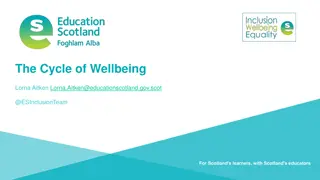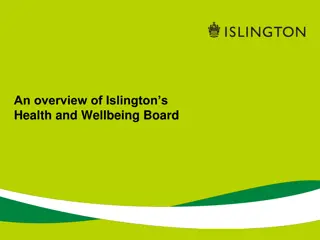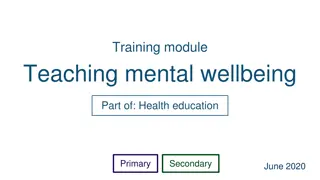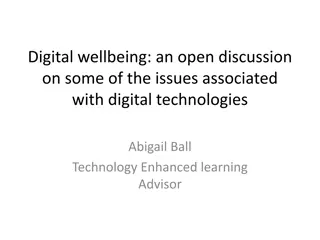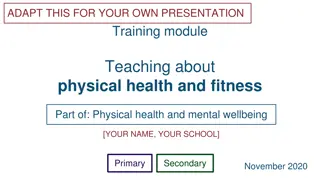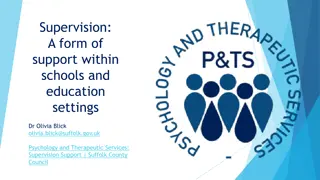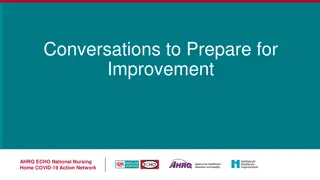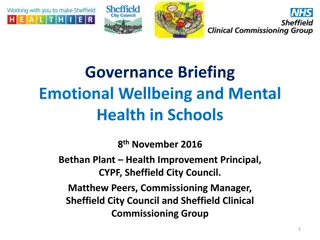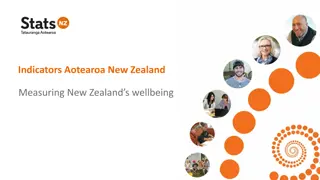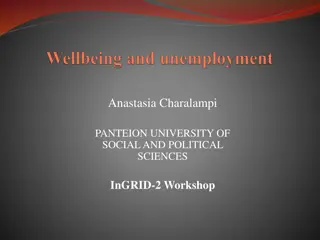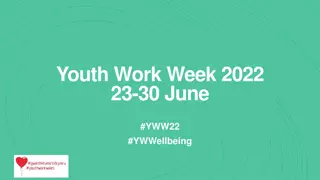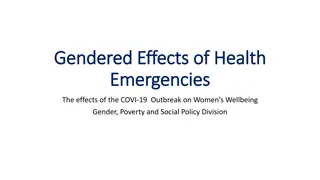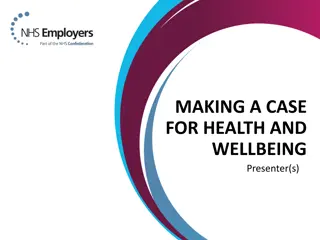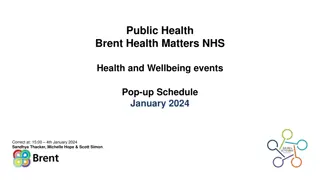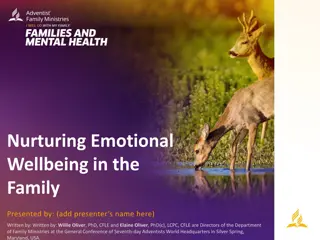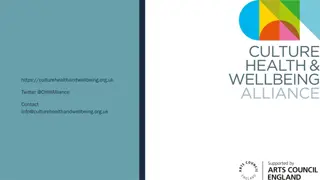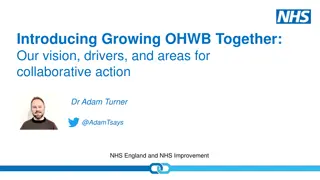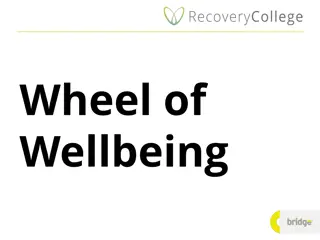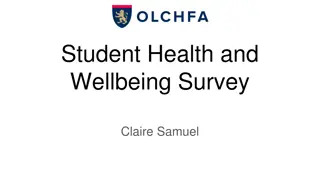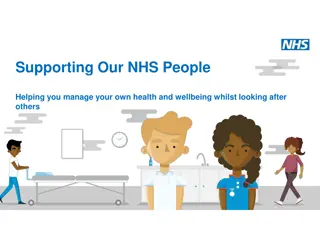Enhancing Health and Wellbeing in Schools: Strategies and Pillars
The program focuses on promoting a whole school approach to health and wellbeing, emphasizing eight key principles including working with parents/carers, student voice, curriculum, and leadership support. The pillars of Healthy Eating, Emotional and Mental Health, Drugs, Alcohol, Tobacco, Physical Activity, Sex and Relationships, and PSHE/SMSC are crucial components. Leadership, student involvement, and implementing strategies at both individual and organizational levels play a vital role in fostering a healthy school environment.
Download Presentation

Please find below an Image/Link to download the presentation.
The content on the website is provided AS IS for your information and personal use only. It may not be sold, licensed, or shared on other websites without obtaining consent from the author. Download presentation by click this link. If you encounter any issues during the download, it is possible that the publisher has removed the file from their server.
E N D
Presentation Transcript
Tameside Children & Young Peoples HEALTH & WELLBEING PROGRAMME Supporting the Whole School Approach to Health and Wellbeing
Eight principles that promote a whole school approach to Health and Wellbeing 5. Working with parents/carers to support inclusion and impacting the health and wellbeing of the community 3. Staff 4 An ethos and environment that promotes and enables healthy lifestyles 6. Ensure policy structures and formalises the healthy ethos 7. Identifying, targeting and supporting individual needs development to support their own health and wellbeing and that of the students 1. Enabling student voice to influence decisions 2. Curriculum, teaching and learning 8. Leadership and Management need to support and champion efforts to promote health and wellbeing
5 pillars needed for Health &Wellbeing Healthy Eating, Food and Nutrition Healthy Eating, Food and Nutrition Emotional and Mental Health Emotional and Mental Health Drugs, Alcohol and Tobacco Drugs, Alcohol and Tobacco Physical Activity Physical Activity Healthy Eating, Food and Nutrition Sex and Relationships Sex and Relationships Emotional and Mental Health Drugs, Alcohol and Tobacco Physical Activity Healthy Eating, Food and Nutrition Sex and Relationships Emotional and Mental Health Drugs, Alcohol and Tobacco Healthy Eating, Food and Nutrition Personal, Social, Health and Economic (PSHE) & Spiritual, Moral, Social and Cultural (SMSC) A range of guidance and resources is available from webpage
Leadership and Management Support from the senior leadership team is essential to ensure that efforts to promote health and wellbeing are accepted and embedded with the school. Top Tips/ Thoughts: Is health and wellbeing (PSHE & SMSC) on staff meeting agenda? Do you have a school governor that champions health and wellbeing? Does your school acknowledge the links between health and wellbeing and educational attainment? Having a governor with knowledge and understanding of health and wellbeing is highly desirable in championing organisation wide practices. Whole school approach
Student Voice Involving students in decisions that impact on them can benefit their health and wellbeing by helping them to feel part of the school and wider community and to have some control over their lives. At an individual level, benefits include helping students to gain belief in their own capabilities, including building their knowledge and skills to make healthy choices and developing their independence. Collectively, students benefit through having opportunities to influence decisions, to express their views and to develop strong social networks. Top Tips/ Thoughts: Does your school have pupils that are health and wellbeing champions? How do you allow them to exercise their role? What is the role of the school council with regards to health and wellbeing? How can the pupils get more involved in the delivery of health and wellbeing education?
Curriculum, teaching and learning School-based programmes relating to the learning of health and wellbeing has the potential to help children and young people acquire the skills they need to make good academic progress as well as benefit pupil health and wellbeing. Top Tips/ Thoughts: Can learning of health and wellbeing be cross-curricular? Is the learning of health and wellbeing embedded all year round and not just a drop down day? Does your school attend the local PSHE Network? Is your school signed up to the PSHE Association? Opportunities exist to develop and promote social and emotional skills through both a dedicated Personal Social Health and Economic education (PSHE) curriculum and the wider curriculum.
Staff Development Top Tips/ Thoughts: Is your school working towards the Workplace Wellbeing Charter National Standards? www.wellbeingcharter.org.uk/ Does your school promote an ethos that supports staff wellbeing? Does your school promote Be Well Tameside the local FREE health improvement service? Do you ensure staff are able to take time to received training that is offered to them? It is important for staff to access training to increase their knowledge of health and wellbeing, and to equip them to be able to identify difficulties in their students. Promoting staff health and wellbeing is also an integral principle of the whole school approach to health and wellbeing.
Ethos and environment The physical, social and emotional environment in which staff and students spend a high proportion of every week day has been shown to affect their physical, emotional and mental health and wellbeing as well as impacting on attainment. Top Tips/ Thoughts: Does the school s ethos/ values include health and wellbeing? Do you display the students work towards the 5 pillars of health & wellbeing? Does your school environment promote physical activity? E.g. daily mile Do you have safe/calm places for students (and staff)? Are these well identified?
Working with parents and carers Top Tips/ Thoughts: Do you regularly communicate and promote with parents about health and wellbeing this could be promoting the Change4Life campaign? Do you invite parents in to help their understanding of what is being taught in the curriculum e.g. RSE? Do you send homework that includes the input for parents and carers? The family plays a key role in influencing children and young people s health and wellbeing. There is strong evidence that being inclusive for parents and carers, as well as implementing universal and targeted interventions supports parenting and family life. Offering a combination of emotional, parenting and practical life circumstances (combining drug, alcohol and sex education, for example) have the potential to yield social as well as economic benefits.
Policy To ensure actions are integrated, sustained and monitored for impact, it is important that a commitment to addressing health and wellbeing is referenced within improvement plans, policies (such as safeguarding; confidentiality; personal, social, health and economic (PSHE) education; social, moral, spiritual and cultural (SMSC) education; behaviour and rewards) and practice. Top Tips/ Thoughts: Can you put health and wellbeing within all policies e.g. managing attendance? Are your policies (focused on health and wellbeing) up to date? Are your policies strongly communicated with staff, parents and carers? How do you know these policies are being implemented effectively?
Individual Needs Top Tips/ Thoughts: All young people will have individual needs - how can a whole school approach be used to support the diverse range of individuals needs? How are all learners made to feel welcomed and included, having their individual differences respected and celebrated within the school community? Are the school opportunities engaging and accessible to all? Are your policies regularly reviewed with feedback received from outside support agencies, families and young people? Are systems in place to identify needs as quickly as possible?
